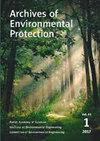基于机器学习算法和地面激光雷达的北京PM2.5小时浓度预测
IF 1.4
4区 环境科学与生态学
Q4 ENVIRONMENTAL SCIENCES
引用次数: 2
摘要
PM2.5的预测对环境预报和大气污染防治具有重要意义。本研究采用四种机器学习方法、地面激光雷达数据和气象数据对北京市地面PM2.5浓度进行预测。在四种方法中,随机森林(RF)方法在预测地面PM2.5浓度方面最有效。与BP神经网络、支持向量机(SVM)和各种线性拟合方法相比,RF方法的拟合精度提高了10%。该方法能较好地描述不同气象条件下PM2.5浓度的时空变化,具有较低的均方根误差(RMSE)和均方差(MD),一致性指数(IA)达到99.69%。在不同天气条件下,PM2.5浓度的逐时变化具有较好的描述能力。本文分析了RF方法中输入变量的权重,构建了一个污染案例来对应输入变量与PM2.5之间的关系,并通过HYSPLIT反向轨迹分析了污染物的来源。该方法可以研究PM2.5与大气污染变量之间的相互作用,为大气污染的预防和预测提供新的思路。本文章由计算机程序翻译,如有差异,请以英文原文为准。
Prediction of PM2.5 hourly concentrations in Beijing based on machine learning algorithm and ground-based LiDAR
The prediction of PM2.5 is important for environmental forecasting and air pollution control. In this study, four machine learning methods, ground-based LiDAR data and meteorological data were used to predict the ground-level PM2.5 concentrations in Beijing. Among the four methods, the random forest (RF) method was the most effective in predicting ground-level PM2.5 concentrations. Compared with BP neural network, support vector machine (SVM), and various linear fitting methods, the accuracy of the RF method was superior by 10%. The method can describe the spatial and temporal variation in PM2.5 concentrations under different meteorological conditions, with low root mean square error (RMSE) and mean square deviation (MD), and the consistency index (IA) reached 99.69%. Under different weather conditions, the hourly variation in PM2.5 concentrations has a good descriptive ability. In this paper, we analyzed the weights of input variables in the RF method, constructed a pollution case to correspond to the relationship between input variables and PM2.5, and analyzed the sources of pollutants via HYSPLIT backward trajectory. This method can study the interaction between PM2.5 and air pollution variables, and provide new ideas for preventing and forecasting air pollution.
求助全文
通过发布文献求助,成功后即可免费获取论文全文。
去求助
来源期刊

Archives of Environmental Protection
ENVIRONMENTAL SCIENCES-
CiteScore
2.70
自引率
26.70%
发文量
0
期刊介绍:
Archives of Environmental Protection is the oldest Polish scientific journal of international scope that publishes articles on engineering and environmental protection. The quarterly has been published by the Institute of Environmental Engineering, Polish Academy of Sciences since 1975. The journal has served as a forum for the exchange of views and ideas among scientists. It has become part of scientific life in Poland and abroad. The quarterly publishes the results of research and scientific inquiries by best specialists hereby becoming an important pillar of science. The journal facilitates better understanding of environmental risks to humans and ecosystems and it also shows the methods for their analysis as well as trends in the search of effective solutions to minimize these risks.
 求助内容:
求助内容: 应助结果提醒方式:
应助结果提醒方式:


